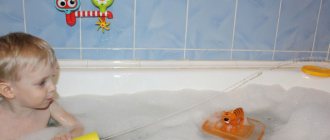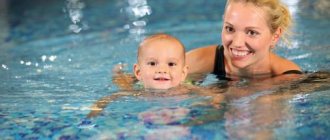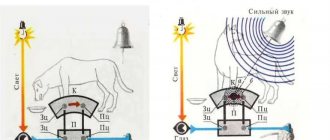Floating on water is a useful skill for every person. Therefore, many modern parents strive to teach their baby to swim in the first months of life. In this regard, they have many questions: “Is this harmful for the child? At what age is it best for a child to start swimming? Where is the best place to do this”, etc. These are the questions we will try to answer for you today.
Infant swimming
Every parent wants their baby to grow up healthy and fully developed. Today there are a lot of developmental techniques for infants that allow you to make your desire come true. Including infant swimming. Is it really such a useful activity or just a fad when you can start swimming, at home or in the pool - there are many questions. The time has come to find answers to them and provide new mothers and fathers with all the necessary information, because any mistake can cause harm to their beloved baby.
Preparation
Water gymnastics is useful only if it is performed correctly.
In order for the lesson to be successful, it is important to prepare for it. You should purchase everything you need: a baby bath, an inflatable ring. To keep your baby interested, you can take toys. You also need to prepare a towel and diapers for swimming. The container in which water aerobics will take place should be thoroughly cleaned using soda and water.
It is important to organize an optimal indoor microclimate. The temperature should vary between 20-22 degrees, and the humidity should be at 50-60%. It is recommended to close the windows to prevent drafts.
What is infant swimming
As is known, in medicine the attitude towards various types of developmental activities is quite ambiguous. Swimming is no exception. On the territory of the USSR, they learned about this technique thanks to Igor Charkovsky, a rescue instructor, who in the 60s made a special tank for water activities with his premature daughter. By 3 months, the baby not only improved her health, but also significantly outstripped her peers in development. Charkovsky began consulting maternity hospitals on the introduction of infant swimming into practice. However, after a couple of years, the technique was considered dangerous and was banned. And only in the late 70s they started talking about infant swimming again, largely thanks to a book about swimming for newborns, published by the chairman of the swimming federation, Zakhary Pavlovich Firsov.
At what age should you start training?
Having experienced the excitement of the first bath, you probably noticed that your baby splashes happily in the bath. And more courageous parents also know that if the baby is lowered with his head under water, he will hold his breath and feel quite comfortable. The explanation for this is an innate reflex, thanks to which the baby remembers the time spent in the mother’s belly, floating in liquid. However, by 3–4 months, the reaction to being in water will begin to fade, so it will be much more difficult to accustom a toddler to swimming. Conclusion: you need to start swimming lessons with your baby at 3-4 weeks. This is due to the fact that
- the wound on the navel will already heal;
- the butuz will begin to gain weight, adapting to an environment that is still unusual for itself;
- innate reflexes will not fade away yet.
Principles of infant swimming
The success of the classes depends on how well the preparatory work is done. If you make a list of principles for swimming with babies, then, in addition to what has already been mentioned, starting from 3–4 weeks, you can highlight 4 positions.
- The principle of purity. The bath or pool must be perfectly clean. In the first case, the container must be washed with baby or laundry soap, and in the second, make sure that all sanitary and hygienic standards are observed by asking for the conclusions of the relevant regulatory organizations.
If you plan to exercise in the pool, be sure to inquire about the availability of documents confirming compliance with sanitary and hygienic standards there - The principle of quality. In this case we mean water quality. For home swimming, this can be either boiled or purified water. It is important that it does not contain potassium permanganate or herbal infusions - the little one may swallow it. In swimming pools, the water is usually purified with chlorine, which is not entirely beneficial for the baby’s respiratory system. But ultraviolet cleaning is what you need.
- The principle of comfort. We are talking about water temperature. The recommended norm is 31–32 degrees. But it’s not worth starting with such low indicators. For the first time, the water should be 36–37 degrees. We are gradually reducing the indicators to the required levels. Please note: if the baby cries for several minutes, then it is quite possible that he is cold, so do not lower the temperature yet. But if the baby is lethargic and inactive, then he is probably hot.
- The principle of correct timing. Swimming lessons can be started 40–60 minutes after meals. The child should not want to sleep.
How to teach a baby to swim
Tips on how to teach a baby to swim in the bathtub are:
- Holding the child carefully, lower him into the water. We need to see how he will feel in it. If the baby cries, there is no need to take him out immediately. It will take him some time to get used to it.
- If the baby has stopped crying, you need to place him horizontally, holding him by the back. Mom or dad should stand firmly on the floor while doing this.
- After you have successfully taught your baby to swim, you can perform simple physical exercises in the water.
Exercises and gymnastics
Teaching a baby to swim is very simple, because he has no fear of water. If the parents have never bathed the baby, the pediatrician demonstrates to them educational infant swimming in the bathroom at home.
You can perform simple strengthening exercises in the bathroom:
- Place the baby on his back, holding him with his palm. The hand should be slowly moved to the back of the head. The child in this position is stable in the water, and the mother only supports him.
- Place the baby tummy down. Mom picks up the baby's head.
- Place the baby horizontally into the water. Place the leg near one of the sides. Then he pushes off from the wall and tries to swim on his own. This exercise is done if the baby feels confident in the water.
- Place the baby in the water, tummy down, so that the entire body is submerged and the head is on the surface. Then you need to show the baby how to splash in the water.
Swimming on your stomach
- When your baby masters these exercises, you can swim with the toy.
- When a child can swim independently on his stomach or back, it is useful to perform the figure eight exercise.
- Holding the baby's tummy from below, you should carefully lift it and lower it back. This exercise coordinates well the function of the cardiovascular system.
How to dive
Parents are interested in how to dive a baby in the bathtub. It is allowed to start diving if the baby feels stable in the water. When completely immersed in water, the baby will reflexively hold his breath. Diving for babies in the bathtub is not dangerous, there is no need to be afraid of it.
You can teach a baby to dive if he swims for 5-10 minutes. Having fixed it in your hands, dip it in water for 2-3 seconds. This procedure should be repeated several times. There is no need to make your child tired - classes should bring positive emotions. The maximum duration of the dive is 10 seconds.
Training methods for newborns and infants
Swimming lessons with infants should be systematic, that is, not only regular, but also corresponding to certain proven methods. At the moment, there are 3 popular systems of work, each of which has been tested by more than one generation of infants.
This is interesting. There are many proprietary techniques that are practiced in specific health centers. However, they are all, to one degree or another, based on these three.
Firsov's technique
The goal of working on this system is that by the age of one year the little one should:
- stay on the water for 20–30 minutes;
- dive shallowly (for a toy or just because);
- be able to jump from a low bridge into the water without panicking.
Work towards achieving the set goal is progressing gradually. It begins with explaining to the baby that he will swim, then the baby is lowered into the water, and after the period of adaptation to water is completed, the child is supported under the tummy or back and placed on the water.
Charkovsky's technique is very controversial, be careful!
It is worth noting that this activity system was developed for premature babies, so it may not be suitable for babies born at full term. Charkovsky's principle is surprise and sharpness: the baby is quickly immersed under water with his head, then taken out and immediately immersed again without delay. One lesson lasts at least 30–40 minutes. In a short moment of surfacing, the baby manages to take a breath of air, but while there is no oxygen in the body, the brain is nourished in a more intensive mode due to the body’s reaction to danger. Such stress helps to develop more intensively physically and mentally.
The technique is widely criticized among experts for its danger to the brain - as a result of prolonged diving, the baby develops hypoxia. It is difficult and even dangerous for the child’s life to independently implement Charkovsky’s method in practice.
Vladimir Guterman’s technique is the most popular today
In the 60–70s, the author worked in the largest outdoor swimming pool in Europe, “Moscow,” where he observed children involved in therapeutic and sports swimming. Subsequently, this experience was systematized into its own methodology. It consists of 4 stages:
- up to 3 months of age (massage, gymnastics simulating swimming, actual exercise in water);
- from 3 to 6 months (they explain to the baby how to swim, show elements of exercises, support), so to speak, the conversational stage;
- from 6 to 9 months (children swim independently, dive);
- From 9 months, little swimmers swim on their own and dive for toys.
The benefits of this activity for babies
When thinking about swimming lessons with a baby, parents should clearly understand: their goal is not to educate an Olympic reserve, but to improve the health of the little one. Swimming allows you to achieve very high results in this, namely:
- accustoms the child to changes in water temperature, which helps strengthen the immune system, and therefore reduces the risk of catching a cold;
- helps the muscle corset take shape and determines correct posture in the future;
- significantly faster (compared to massage and stroking) improves the motor system, that is, strengthens/relaxes the muscles of the arms, legs, back, neck, and this, in turn, will allow the baby to sit up faster, start crawling and walking;
- to absorb more oxygen, the body releases red blood cells, which increase hemoglobin in the blood;
- normalizes blood pressure;
- the maxillary sinuses are cleared, harmful bacteria and allergens are washed out, which reduces the risk of a runny nose;
- has a calming effect on the baby, he falls asleep faster and more soundly, without creating additional anxiety for the mother associated with frequent awakenings at night;
- being in the water, the child learns to express himself with gestures and movements, that is, the mother begins to better understand her baby;
- teaches the child to approach bodies of water without fear.
The main principle of swimming with a baby is that the process should be enjoyable.
Positive effect on the body
Not many people know that little children can swim perfectly from birth. They can hold their breath and dive, have fun splashing around in the bathtub. This trend is explained by the fact that the baby has an innate reflex, because in the mother’s womb he was in a liquid environment for 40 weeks.
The ability to swim disappears 3 months after birth. Pediatricians recommend doing certain exercises with your child while bathing so that he does not lose the ability to stay afloat. In addition, infant swimming is very beneficial for children's development.
Why swimming is good for babies:
- Regular water procedures are beneficial for anyone, especially young children. This allows the body to more easily learn to deal with temperature changes.
- Systematic exercises contribute to the formation of beautiful and even posture and strengthen the spine.
- Doing exercises at home in the bathroom helps maintain normal hemoglobin levels.
- Diving causes a small amount of water to enter the baby's nose. This is an excellent prevention of a runny nose; this “rinsing” also removes allergens and bacteria from the mucous membrane.
- After bathing, the baby's heart rate improves.
- If you teach your child to swim from a very young age, in the future he will not be afraid of open water.
Arguments against: possible harm
Every medal has a downside, and swimming is no exception.
- If temperature and other standards are not observed, the baby may develop diseases of the upper and lower respiratory tract. And when swimming in the pool, this probability becomes 4 times higher than for those toddlers who do not swim.
- There is a risk of problems with the gastrointestinal tract, as the baby swallows water during exercise.
With such close contact, water will in any case enter the baby’s gastrointestinal tract. - Some psychologists believe that children with whom they have been involved in infant swimming may become hyperactive in the future and it will be difficult for them to maintain mental balance. And also, as adults, they often begin to get involved in extreme sports. And all because at an early age they lose their sense of danger.
Please note that the arguments concern cases where classes are conducted according to all the rules. And the list of harm caused by swimming in violation of accepted norms is endless. This also includes infant mortality due to careless handling of an infant in water.
Errors in learning
In addition to following the techniques and rules described above, it is important to avoid other mistakes. Let's note what to avoid during lessons:
- do not resort to extreme methods. Throwing yourself into the water relying on innate instincts has nothing to do with learning. This “old-fashioned” method is fraught with serious psychological consequences: from a persistent fear of water to distrust of parents (much depends on the age at which a person experienced a similar situation);
- Don't ignore your student's mood. If he is worried, anxious or upset about something, listen to him and only then decide to continue the lesson;
- Don't give negative feedback to unsuccessful attempts. Focus on successes. They definitely exist;
- Don't expect a child's coordination to be identical to an adult's. Consider age-related physiological capabilities;
- do not use inflatable rings. They form an incorrect habit of standing upright. To protect your baby and reduce the load, it is better to use vests or armbands (and if possible, it is better to do without them altogether).
That’s probably all that parents who are starting to learn the profession of a personal instructor need to know. Help your child fall in love with the water, teach him basic movements, practice hand-foot coordination and proper breathing. Do not rush to start a new stage if the child has not learned and consolidated the acquired skills. During classes, follow the recommendations described in the article, take into account the age and psychological characteristics of the ward, maintain a positive attitude and believe in yourself!
When is it necessary to swim?
Unfortunately, many toddlers are born with health problems. But some of these disorders can be successfully corrected by swimming:
- muscle hypertonicity (excessive muscle tension);
- muscle hypotonicity (weakness of the muscle corset);
- low weight (less than 2.5 kg);
- dysplasia, arthrosis of the joints;
- congenital defects in musculoskeletal tissue;
- torticollis;
- Cerebral palsy.
Swimming is very helpful for hip dysplasia.
In addition, swimming is recommended for babies who were born after a cesarean section.
Contraindications
It is very important to pay attention to situations where swimming lessons for a child can aggravate already serious health problems:
- disturbances in the functioning of the musculoskeletal system, when fixation of arms and legs is necessary;
- congenital heart defects;
- purulent dermatitis;
- seizures due to neurological disorders.
It is not recommended to exercise if you have a cold or viral disease. However, after recovery, classes can be continued.
Working out at home
Kids react very sensitively to the mood of adults, so start classes in a good mood. And one more thing: you should be comfortable.
Preparation
Don't expect to stand for a long time leaning over the bathtub - put a chair. Have a clean diaper or soft towel ready to dry your little swimmer after the activity.
This is interesting. In the absence of drafts, pediatricians advise slightly blotting the child’s skin and carrying him into the room naked - this is one of the elements of hardening.
To prevent young parents from being nervous, an inflatable lifebuoy or a special cap with foam padding can be used as a safety measure. All actions with the baby in the water must be accompanied by a calm and confident voice.
Communication with water should begin by immersing the little one’s hand and then the foot. And don’t forget to accompany all actions with your comments.
Support for the baby can be carried out in two ways: under the back of the head (the baby lies on his back, and the adult picks up his head under the back of the head) and under the chin (the baby lies on the water on his tummy, the chin in the adult’s palm).
You can support it on your stomach either under the chin or by the back of the head.
Exercises
In fact, swimming at home can be just as exciting as swimming in a pool. You just need to choose the right exercises. It is important that they are approved by a pediatrician.
All swimming exercises must be approved by a pediatrician, and ideally also a surgeon and neurologist
"Turns and Pushes"
Instructions:
- We bring the toddler's legs closer to the walls of the bathtub.
- After the baby feels support under his legs, he will push off and then roll over from his back to his stomach.
The parent's help in this exercise is reduced to a minimum: support the baby in the process of pushing and turning over.
"Splashing"
The exercise is performed while lying on the water on your tummy. While supporting the baby by the chin, you need to show him what funny circles on the water are formed from splashing.
“Catching up with the boats”
Children love to chase toys in the water
. Instructions:
- We place the baby on his stomach and support his chin.
- We put a toy in front of the little one.
- We try to reach her, saying: “Look, our boat is sailing away, let’s catch up!” Over time, you can increase speed and increase the distance to the target.
"Eight"
This exercise can be started when the baby masters moving in a straight line.
Instructions:
- We place the child on his back or tummy, supporting him accordingly.
- Having selected a suitable speed, we imitate the figure of the number 8.
"Let's ride on a swing"
Instructions:
- We place the child on his stomach and support his chin.
- We make sure that the head remains above the water and imitate swimming back and forth, up and down. To do this, we immerse and lift the baby with smooth movements.
"Let's dive!"
Exercise causes fear in some parents, but children, as a rule, are not afraid of it, in fact, some even look forward to it.
Instructions:
- We start with the theoretical stage. For 10 days we regularly say the word “Dive!” and blow in the baby's face. The baby will instinctively close its eyes and hold its breath.
- Add a little water: after saying the phrase, splash some water in the little one’s face.
- We say the key phrase and lower the baby’s head under water for 1–2 seconds. Gradually increase the time spent under water to 5–6 seconds.
This is interesting. We start diving only after the baby has already bathed a little.
How to teach your baby to swim in the bathtub at home - video
Recommendations for parents
Teaching a small child to swim and dive at home in the bathtub is not such a difficult task for parents. Try to adhere to the recommendations presented as much as possible and you will be able to get the maximum benefit from the classes.
- If you have clearly set a goal for yourself that you want to teach your child to swim, you need to start doing this immediately after the umbilical cord has healed. This is approximately 3-4 weeks after birth. At this time, swimming reflexes have not yet disappeared, so it will be easier for the child.
- Purchase in advance such attributes as a hat and a circle around the neck. If you teach your child to float on water in the bathroom at home, then you must do this with a circle - for safety reasons.
- The first few times water training should be carried out at a temperature of 35 degrees. Monitor your child's behavior. The baby may cry for the first minute after immersion; the process of bathing with a circle causes a little discomfort. If he does not calm down for a long time, it means that he is not satisfied with the water temperature.
- Swimming is also beneficial for infants because it strengthens the body. While swimming, the water begins to gradually cool down - this is very good, you should not bring it to 35 degrees again.
- If you plan to train your baby regularly, keep the bathroom clean. Wash it once a week with baking soda and treat it with laundry soap before bathing your baby.
- Swimming is very beneficial for infants, but children can sometimes become capricious. For example, if you don’t get enough sleep or are not in the mood. It is also very important to train your child about an hour after he has eaten. During this period, the milk is already digested, and the baby will not experience discomfort in the stomach.
- If there is no draft in the apartment, pediatricians do not recommend wiping the baby’s body dry after bathing. Dry your child with a dry diaper, this will be enough. Next, the cap and the circle around the neck should be carefully removed.
- Before you practice diving, make sure that the circle is held tightly to your neck and that your cap covers your ears. The child must feel comfortable, otherwise he will be capricious.
Swimming in the pool
Depending on their preferences, parents choose group or individual pool lessons.
Preparation
It is very important that the baby is properly assembled into the pool. Have to take:
- panties for swimming (for very small children this can be a special diaper for swimming);
- a warm and large towel;
- a hat that you will put on immediately after class to prevent your ears from getting cold;
- children's bath product to rinse off the pool water after class;
- a circle for swimming (just in case for your own peace of mind);
- toys for the baby that he loves, acceptable in the pool.
Swimming equipment - photo gallery
Everything you need to know about swimming pool classes
If the child is used to the trainer and responds well to him, then the mother may not go into the water at all, but watch the process at the side.
The first lessons are best done with an instructor.
On average, a pool session lasts about 90 minutes. Of these, 20–25 are spent on a preliminary warming massage for the baby. True, the first lesson lasts only 10 minutes, each subsequent training session the time increases, and within a month you will reach the average timing.
Exercises for training in the pool are identical to those used for training in the bathroom.
This is interesting. Swimming can be combined with hardening. To do this, some parents pour cold water on their little ones after class, but few of their children enjoy this procedure. Therefore, doctors recommend simply letting the body dry without wiping it - this is also an effective hardening technique.
A set of exercises with a baby in the pool - video
Necessary equipment
No child’s bath is complete without necessary and useful things. The most important and necessary item is a circle for babies. This is an indispensable assistant for a mother when bathing her child. There are a large number of circles of different price and age categories. They differ from ordinary ones in the presence of a chin rest for the baby and are placed directly on the neck.
You can get a bathing slide, a bathtub, a seat, and a mattress. But these things, unlike the circle, are not essential items. And in order to make bathing more interesting and fun, you can get bath toys.
Benefits of swimming lessons at home and in the pool - table
| In the bathroom | In a swimming pool | |
| Comfort for the child | A newborn baby is still getting used to the new environment, so children under one month old are recommended to study in a special baby bath with their mother nearby. This way the child will feel the presence of his mother nearby, and the small space will not cause fear. | Very often, newborn children are afraid of large water, extraneous sounds, and noise. After all, not only they, but also other children are engaged in the pool. That is why it is recommended to bring children aged two to three months to the pool. |
| Lessons with a trainer | Doctors recommend starting early swimming exercises only in the presence of a specialist. When mom gets used to it a little, you can study on your own. But often calling a trainer to your home is problematic and expensive. | In the pool you can choose an individual schedule, choose the instructor you like and be completely sure that the classes will be carried out correctly and usefully. |
| Safety | Very often, mothers who try to practice infant swimming on their own do not know the principles and methods of training. Water can get into the baby's lungs, and this is life-threatening. | In the pool, classes are held only under the supervision of experienced specialists, so the child and mother are completely safe. |
| Exercises in groups | Very often, children do not want to swim on their own: they are scared, uninterested, etc. At home there is no opportunity to carry out exercises with several children. | In a group, the child pays attention to his peers. When a child sees that others are swimming with pleasure, he is not so afraid to try new tasks and exercises himself. |
| Conditions | In this regard, a home bath comes out on top. Mom can prepare boiled water without chlorine, wash the bathtub or large bathtub well, and can be sure that no infections are scary for her baby. | Often, chlorine, which is used to disinfect water, causes allergic reactions, problems with the respiratory system and digestion, when swallowing water from the pool. There is a risk of catching some kind of infection. |
Pediatricians' opinions
Doctors for the most part are very positive about infant swimming. True, many of them still advise practicing at home in order to reduce the risk of harmful microorganisms getting into the baby’s digestive tract, as well as on his skin . Evgeny Olegovich Komarovsky, like his colleagues, insists that swimming is useful only when it is carried out in compliance with all precautions, and the baby is in a good mood. In addition, pediatricians often emphasize that bathing in cool water promotes sound sleep for the baby, and is also an important step in the hardening process.











